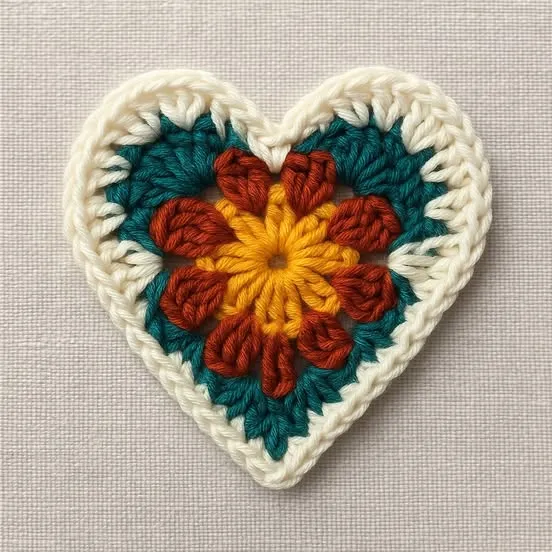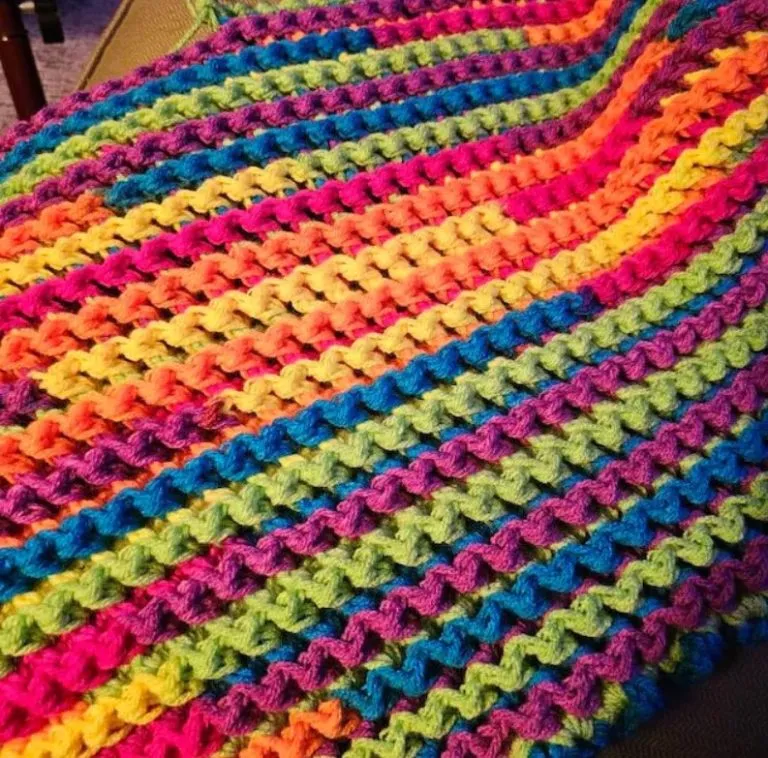
The ZigZag Waffle Stitch is one of the most beautiful and versatile crochet patterns you can master. It combines the deep, textured look of the classic waffle stitch with a gentle zigzag movement, creating a stunning effect that’s both elegant and modern.
Perfect for blankets, scarves, dishcloths, and home décor, this stitch offers a delightful balance of structure and flexibility, making it suitable for both beginners and experienced crocheters alike.
When crocheting the ZigZag Waffle Stitch, you’ll notice that the pattern forms a subtle raised texture resembling tiny 3D blocks, enhanced by a wave-like motion across the rows.

This unique combination makes the fabric soft, warm, and visually interesting — ideal for cozy winter projects or stylish handmade gifts. It’s a pattern that stands out while remaining simple enough to enjoy working on for hours.
The best part about learning the ZigZag Waffle Stitch is its versatility. You can use it to create chunky afghans for the couch, delicate shawls with light yarn, or textured pillow covers that bring a handmade charm to your living space. Once you understand the stitch sequence, you’ll find endless ways to customize it with different yarn weights and color transitions, making every project truly unique.
The ZigZag Waffle Stitch is built using a combination of front post double crochets (FPDC) and regular double crochets, arranged in a rhythmic pattern to create a textured, grid-like surface with diagonal movement. The “zigzag” effect comes from carefully alternating stitch placement to make the texture shift slightly from row to row, forming beautiful waves across the fabric.
To start, you’ll need to chain a multiple of 4 plus 3 stitches for your foundation chain. This ensures that the pattern stays aligned throughout the project. After your base row, you’ll alternate between standard double crochet rows and rows that include front post stitches to build the depth of the waffle texture.
The secret behind the ZigZag Waffle Stitch lies in the consistent repetition of post stitches. These stitches pull the yarn forward, creating raised ridges that look like waffles. By offsetting them slightly in each row, the result is a zigzag pattern that’s both geometric and flowing.
When choosing yarn for this stitch, medium-weight (worsted) yarn works best, as it highlights the pattern without being too bulky. However, if you want a softer and fluffier texture, try using a chunky yarn for a warm blanket or scarf. For lighter projects, cotton yarn gives a crisp, clean definition that’s great for decorative pieces.
Tension control is essential when working on the ZigZag Waffle Stitch. Too tight, and the fabric will feel stiff; too loose, and the texture may lose its depth. Practice a small swatch first to find your ideal tension before starting your main project.
Finally, remember that this stitch tends to pull the fabric in slightly, so it’s best to make a foundation chain a bit longer than your intended final width. Blocking at the end will help even out edges and enhance the zigzag definition.
Starting your ZigZag Waffle Stitch project is straightforward once you understand the repeating pattern. Follow these simple steps to create your first swatch or full-size piece.
Step 1: Create a foundation chain that is a multiple of 4 plus 3. For example, chain 31 for a small practice swatch.
Step 2: In the second chain from your hook, work a double crochet across the entire row. This will form your foundation row.
Step 3: Chain two and turn your work. In this row, alternate between one front post double crochet (FPDC) and three regular double crochets. The FPDC stitches create the raised “waffle” columns.
Step 4: On the next row, shift the FPDC placement by one stitch to create the zigzag effect. This offset creates the wave-like motion in the pattern, giving the ZigZag Waffle Stitch its signature texture.
Step 5: Continue alternating rows in this sequence. Every other row should shift the post stitches slightly to maintain the diagonal movement. Always chain two at the start of each new row for height.
Step 6: Once you reach your desired length, finish the final row with a simple double crochet across to smooth out the top edge.
Blocking your finished piece will enhance the zigzag definition and make the texture more pronounced. Use a damp cloth and gently stretch the fabric to shape it evenly.
The ZigZag Waffle Stitch works beautifully in single-color yarns but also looks amazing with variegated or gradient yarns, which naturally highlight the zigzag movement.
To master the ZigZag Waffle Stitch, consistency and attention to detail make all the difference. Here are some helpful tips for achieving perfect results every time.
First, always maintain even tension. Because of the alternating post stitches, it’s easy to unintentionally tighten or loosen your work. Consistency ensures that the raised waffle squares stay uniform across the project.
Second, mark the start and end of your rows with stitch markers. This helps prevent accidental stitch count changes, which can distort the zigzag shape.
Third, use a hook that complements your yarn type. For example, if you’re using soft acrylic yarn, a metal hook will help the yarn glide smoothly, while a bamboo hook can provide better control for slippery cotton yarns.
Fourth, count your stitches regularly. The pattern’s structure depends on keeping the correct multiple of four. Even one missed or added stitch can interrupt the zigzag rhythm.
Fifth, experiment with color stripes. Changing colors every few rows enhances the visual flow of the zigzag and adds extra depth to your fabric.
Lastly, don’t forget to block your finished project. Blocking is essential for opening up the texture and aligning the zigzag waves, especially for blankets or scarves that need a professional finish.
The ZigZag Waffle Stitch isn’t limited to one type of project — it’s incredibly flexible and can be used in many creative ways. Once you learn the pattern, you’ll find countless opportunities to apply it.
For example, this stitch makes an excellent blanket or afghan pattern. The raised texture traps warmth, making it cozy and perfect for winter.
You can also use it to create textured dishcloths or hand towels. Cotton yarn gives a firm structure, while the ridges help with gentle scrubbing, making it both decorative and functional.
If you’re into home décor, try crocheting pillow covers or cushion panels using the ZigZag Waffle Stitch. The pattern adds a stylish, handmade touch to any room.
Fashion lovers can turn this stitch into chunky scarves, wraps, or ponchos. Using gradient or ombré yarns enhances the zigzag texture, creating a sophisticated and cozy accessory.
For smaller projects, this stitch is great for coasters, placemats, or potholders. The thickness of the waffle texture provides extra insulation and durability.
Finally, advanced crocheters can use this stitch for bags, cardigans, or baby blankets, experimenting with color and structure to create entirely new designs inspired by the basic waffle zigzag pattern.
Q: Is the ZigZag Waffle Stitch suitable for beginners?
A: Yes! It may look advanced, but it’s based on simple double crochet and front post stitches. With a bit of practice, even beginners can master it.
Q: What type of yarn works best for this stitch?
A: Medium-weight yarn (category 4) is ideal. It provides structure and highlights the texture beautifully. Cotton or acrylic blends are excellent choices.
Q: Can I use multiple colors in one project?
A: Absolutely! Color changes can highlight the zigzag pattern, especially when done in stripes or gradient transitions.
Q: Why does my fabric curl at the edges?
A: Slight curling is normal due to the texture. Adding a border or blocking the finished piece will help flatten and stabilize it.
Q: How do I make my waffle texture stand out more?
A: Use tighter tension on front post stitches and slightly looser tension on regular double crochets. This contrast enhances the raised 3D effect.
Q: Can this stitch be used for clothing?
A: Yes, but it’s best for structured pieces like sweaters, jackets, or cardigans. The dense texture provides warmth and definition.
Q: How do I finish the edges neatly?
A: Add a round of single crochet around the border, or use a reverse single crochet (crab stitch) for a polished edge.
Q: How do I care for items made with this stitch?
A: Machine wash on gentle and lay flat to dry. Avoid hanging, as the textured stitches may stretch over time.
The ZigZag Waffle Stitch is a stunning crochet pattern that combines texture, movement, and versatility in one elegant design. Its 3D effect and rhythmic flow make it a joy to create, whether you’re crafting blankets, scarves, or decorative items. The alternating stitches build a rich texture that looks intricate but remains simple enough for anyone to learn.
Now that you know how to make the ZigZag Waffle Stitch, it’s time to pick your favorite yarn, prepare your hook, and start crocheting! Experiment with colors, play with textures, and discover how this timeless pattern can bring warmth and charm to your handmade creations.
